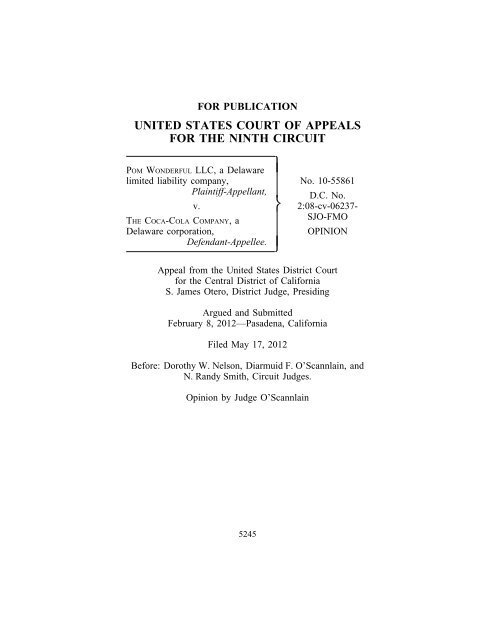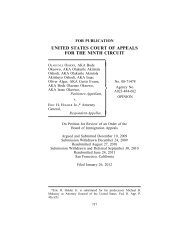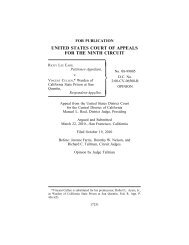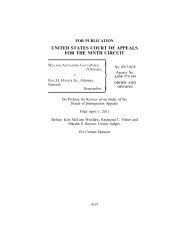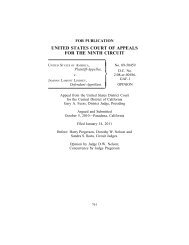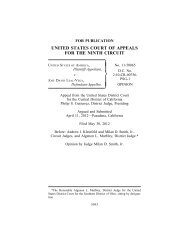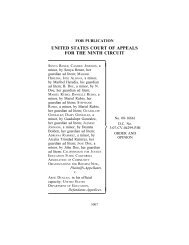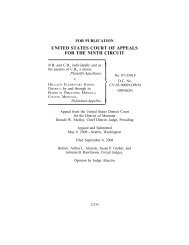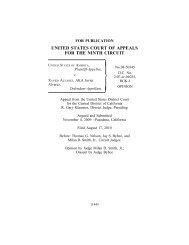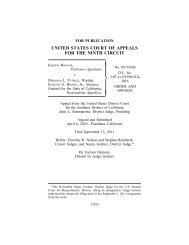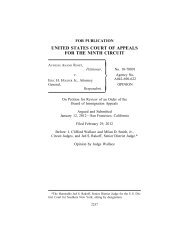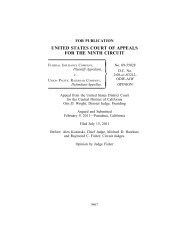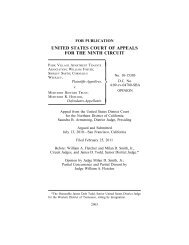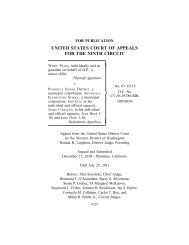Pom Wonderful v. Coca-Cola - Court of Appeals - 9th Circuit - U.S. ...
Pom Wonderful v. Coca-Cola - Court of Appeals - 9th Circuit - U.S. ...
Pom Wonderful v. Coca-Cola - Court of Appeals - 9th Circuit - U.S. ...
Create successful ePaper yourself
Turn your PDF publications into a flip-book with our unique Google optimized e-Paper software.
FOR PUBLICATION<br />
UNITED STATES COURT OF APPEALS<br />
FOR THE NINTH CIRCUIT<br />
POM WONDERFUL LLC, a Delaware<br />
limited liability company, No. 10-55861<br />
Plaintiff-Appellant,<br />
v.<br />
THE COCA-COLA COMPANY, a<br />
⎬<br />
D.C. No.<br />
2:08-cv-06237-<br />
SJO-FMO<br />
Delaware corporation, OPINION<br />
Defendant-Appellee. ⎭<br />
Appeal from the United States District <strong>Court</strong><br />
for the Central District <strong>of</strong> California<br />
S. James Otero, District Judge, Presiding<br />
Argued and Submitted<br />
February 8, 2012—Pasadena, California<br />
⎫<br />
Filed May 17, 2012<br />
Before: Dorothy W. Nelson, Diarmuid F. O’Scannlain, and<br />
N. Randy Smith, <strong>Circuit</strong> Judges.<br />
Opinion by Judge O’Scannlain<br />
5245
POM WONDERFUL v. COCA-COLA CO.<br />
COUNSEL<br />
5247<br />
Seth P. Waxman, Wilmer Cutler Pickering Hale and Dorr<br />
LLP, Washington, D.C., argued the cause and filed the briefs<br />
for the plaintiff-appellant. With him on the briefs were Randolph<br />
D. Moss, Brian M. Boynton, Felicia H. Ellsworth, and<br />
Madhu Chugh, Wilmer Cutler Pickering Hale and Dorr LLP,<br />
Washington, D.C.; Craig B. Cooper, Daniel S. Silverman, and<br />
Daniel A. Beck, Roll Law Group P.C., Los Angeles, California;<br />
and Andrew S. Clare, Loeb & Loeb LLP, Los Angeles,<br />
California.
5248 POM WONDERFUL v. COCA-COLA CO.<br />
Steven A. Zalesin, Patterson Belknap Webb & Tyler LLP,<br />
New York, New York, argued the cause and filed the brief for<br />
the defendant-appellee. With him on the brief were Sarah E.<br />
Zgliniec, Travis J. Tu, and YiLing Chen-Josephson, Patterson<br />
Belknap Webb & Tyler LLP, New York, New York.<br />
OPINION<br />
O’SCANNLAIN, <strong>Circuit</strong> Judge:<br />
We must decide whether the Food, Drug, and Cosmetic Act<br />
bars a Lanham Act claim alleging that the name and labeling<br />
<strong>of</strong> a juice beverage are deceptive.<br />
I<br />
<strong>Pom</strong> <strong>Wonderful</strong> LLC produces, markets, and sells bottled<br />
pomegranate juice and pomegranate juice blends, including a<br />
pomegranate blueberry juice blend. The <strong>Coca</strong>-<strong>Cola</strong> Company<br />
markets and sells bottled juices and juice blends under the<br />
Minute Maid brand. In September 2007, <strong>Coca</strong>-<strong>Cola</strong><br />
announced a new product called “<strong>Pom</strong>egranate Blueberry” or<br />
“<strong>Pom</strong>egranate Blueberry Flavored Blend <strong>of</strong> 5 Juices.” (The<br />
parties dispute the name. We at times refer to <strong>Coca</strong>-<strong>Cola</strong>’s<br />
product as “<strong>Pom</strong>egranate Blueberry” but take no view on<br />
whether this is its actual name.) This product contains about<br />
99.4% apple and grape juices, 0.3% pomegranate juice, 0.2%<br />
blueberry juice, and 0.1% raspberry juice. The front label displays<br />
the product’s name and a vignette depicting each <strong>of</strong><br />
those fruits:
POM WONDERFUL v. COCA-COLA CO.<br />
5249<br />
Believing that it was losing sales to <strong>Pom</strong>egranate Blueberry,<br />
<strong>Pom</strong> sued <strong>Coca</strong>-<strong>Cola</strong> in September 2008. <strong>Pom</strong> alleged<br />
that <strong>Coca</strong>-<strong>Cola</strong> misled consumers to believe that <strong>Pom</strong>egranate<br />
Blueberry consists primarily <strong>of</strong> pomegranate and blueberry
5250 POM WONDERFUL v. COCA-COLA CO.<br />
juices when it actually consists mainly <strong>of</strong> (the cheaper) apple<br />
and grape juices. <strong>Pom</strong> challenged the name, labeling, marketing,<br />
and advertising <strong>of</strong> <strong>Pom</strong>egranate Blueberry. It claimed that<br />
<strong>Coca</strong>-<strong>Cola</strong> violated the false-advertising provision <strong>of</strong> the Lanham<br />
Act, which authorizes suit against those who use a false<br />
or misleading description or representation about any goods.<br />
See 15 U.S.C. § 1125(a). <strong>Pom</strong> also claimed that <strong>Coca</strong>-<strong>Cola</strong><br />
violated California’s Unfair Competition Law (UCL) and its<br />
False Advertising Law (FAL), which prohibit deceptive practices<br />
and misleading advertising. See Cal. Bus. & Pr<strong>of</strong>’l Code<br />
§§ 17200 et seq.; id. §§ 17500 et seq.<br />
<strong>Coca</strong>-<strong>Cola</strong> moved under Federal Rule <strong>of</strong> Civil Procedure<br />
12(b)(6) to dismiss the complaint for failure to state a claim.<br />
The district court partially granted and partially denied the<br />
motion. The court ruled that <strong>Pom</strong>’s Lanham Act challenge to<br />
<strong>Pom</strong>egranate Blueberry’s name and labeling was barred<br />
because <strong>Pom</strong>’s suit “may be construed as impermissibly challenging”<br />
Food and Drug Administration (FDA) regulations<br />
permitting the name and labeling that <strong>Coca</strong>-<strong>Cola</strong> uses and<br />
because <strong>Pom</strong>’s claim could improperly require the court to<br />
interpret and to apply FDA regulations on juice beverage<br />
labeling. But the court also held that <strong>Pom</strong>’s Lanham Act challenge<br />
could otherwise proceed. Specifically, the court ruled<br />
that, although <strong>Pom</strong> could not challenge <strong>Pom</strong>egranate Blueberry’s<br />
name and labeling, it could challenge <strong>Coca</strong>-<strong>Cola</strong>’s other<br />
advertising and marketing <strong>of</strong> the product because those components<br />
<strong>of</strong> the claim would not require the court to interpret<br />
FDA regulations. The court also held that the Food, Drug, and<br />
Cosmetic Act (FDCA), 21 U.S.C. §§ 301 et seq., expressly<br />
preempted <strong>Pom</strong>’s state law claims to the extent the UCL and<br />
FAL impose obligations that are not identical to those<br />
imposed by the FDCA and its implementing regulations.<br />
After <strong>Coca</strong>-<strong>Cola</strong> refused to respond to discovery requests,<br />
<strong>Pom</strong> amended its complaint to bring itself within the scope <strong>of</strong><br />
the court’s earlier ruling on its Lanham Act claim. The<br />
amended complaint repleaded <strong>Pom</strong>’s Lanham Act, UCL, and
POM WONDERFUL v. COCA-COLA CO.<br />
5251<br />
FAL claims. In an apparent effort to overcome the court’s<br />
preemption ruling, <strong>Pom</strong> added to its UCL claim a misbranding<br />
allegation under California’s Sherman Law, which<br />
includes language that is materially identical to the FDCA’s<br />
misbranding provision. See Cal. Health & Safety Code<br />
§ 110660; compare id. with 21 U.S.C. § 343(a)(1).<br />
<strong>Coca</strong>-<strong>Cola</strong> moved under Rule 12(b)(6) to dismiss the<br />
amended complaint. The court denied <strong>Coca</strong>-<strong>Cola</strong>’s motion<br />
and ruled that <strong>Pom</strong> could conduct discovery to clarify which<br />
aspects <strong>of</strong> <strong>Coca</strong>-<strong>Cola</strong>’s alleged conduct constituted labeling<br />
(and thus could not, under the court’s earlier ruling, support<br />
<strong>Pom</strong>’s Lanham Act claim) and which aspects constituted<br />
advertising or marketing (and thus could support the Lanham<br />
Act claim). The court did not address preemption. Discovery<br />
followed.<br />
When discovery was completed, the district court partially<br />
granted summary judgment to <strong>Coca</strong>-<strong>Cola</strong>. The court reiterated<br />
that <strong>Pom</strong>’s Lanham Act challenge to <strong>Pom</strong>egranate Blueberry’s<br />
name and labeling was barred by the FDCA’s implementing<br />
regulations. The court reasoned that through its<br />
regulations, the FDA “has directly spoken on the issues that<br />
form the basis <strong>of</strong> <strong>Pom</strong>’s Lanham Act claim against the naming<br />
and labeling <strong>of</strong> the Juice, and has therefore[ ] reached a<br />
conclusion as to what is permissible.” The court emphasized<br />
that the FDA “has concluded that manufacturers <strong>of</strong> multiplejuice<br />
beverages may identify their beverages with a nonprimary,<br />
characteristic juice, as <strong>Coca</strong>[-]<strong>Cola</strong> does here.”<br />
Because in its view <strong>Coca</strong>-<strong>Cola</strong>’s label “sufficiently comports<br />
with the requirements <strong>of</strong>” FDA juice-labeling regulations—<br />
and because it believed that any further “determination that<br />
naming and labeling must be displayed in a particular way or<br />
fashion” must be made by the FDA—the court held that<br />
<strong>Pom</strong>’s claim challenging the name and labeling <strong>of</strong> <strong>Pom</strong>egranate<br />
Blueberry was barred. The court reached a similar conclusion<br />
specifically about the label’s fruit vignette.
5252 POM WONDERFUL v. COCA-COLA CO.<br />
The court did not revisit its earlier preemption ruling. It<br />
simply ruled that <strong>Pom</strong> lacked statutory standing to pursue its<br />
state law claims. The court reasoned that <strong>Pom</strong> had not established<br />
the statutory standing prerequisite <strong>of</strong> “lost money or<br />
property,” Cal. Bus. & Pr<strong>of</strong>’l Code §§ 17204, 17535, because<br />
<strong>Pom</strong> had not shown that it was entitled to restitution.<br />
The court concluded that triable issues remained on the<br />
non-naming-and-labeling aspects <strong>of</strong> <strong>Pom</strong>’s Lanham Act claim<br />
and permitted <strong>Pom</strong> to proceed to trial on those matters. But<br />
<strong>Pom</strong> conceded that the summary judgment order prevented it<br />
from carrying its burden on the claim and the court therefore<br />
entered judgment for <strong>Coca</strong>-<strong>Cola</strong>. <strong>Pom</strong> timely appealed.<br />
II<br />
On appeal, <strong>Pom</strong> contends that the district court erred in its<br />
holdings that the FDCA bars its Lanham Act claim, that <strong>Pom</strong><br />
lacks statutory standing to pursue its state law claims, and that<br />
the FDCA expressly preempts <strong>Pom</strong>’s state law claims against<br />
the name and labeling <strong>of</strong> <strong>Coca</strong>-<strong>Cola</strong>’s <strong>Pom</strong>egranate Blueberry.<br />
A<br />
[1] The Lanham Act broadly prohibits false advertising. It<br />
authorizes suit against those who use a false or misleading<br />
description or representation “in connection with any goods.”<br />
15 U.S.C. § 1125(a). Such suits can be brought by any person<br />
“who believes that he or she is or is likely to be damaged by”<br />
the use <strong>of</strong> that false description or representation. Id.<br />
[2] The FDCA, meanwhile, comprehensively regulates<br />
food and beverage labeling. It provides that a food is misbranded<br />
if “its labeling is false or misleading in any particular,”<br />
21 U.S.C. § 343(a)(1), or “[i]f any word, statement, or<br />
other information required by” the FDCA or its regulations<br />
“to appear on the label or labeling is not prominently placed
POM WONDERFUL v. COCA-COLA CO.<br />
5253<br />
thereon with such conspicuousness . . . and in such terms as<br />
to render it likely to be read and understood by the ordinary<br />
individual under customary conditions <strong>of</strong> purchase and use,”<br />
id. § 343(f). Though a private plaintiff may sue under the<br />
Lanham Act’s false-advertising provision, the FDCA may be<br />
enforced only by the FDA or the Department <strong>of</strong> Justice. See<br />
id. § 337(a). The FDA, for its part, has promulgated regulations<br />
that address how a manufacturer may name and label its<br />
juice beverages. See, e.g., 21 C.F.R. § 102.33(c), (d).<br />
As sometimes happens with two broad federal statutes, the<br />
Lanham Act and the FDCA can conflict with each other.<br />
When faced with a potential conflict, “[c]ourts try to give as<br />
much effect to both statutes as possible.” Schering—Plough<br />
Healthcare Prods., Inc. v. Schwarz Pharma, Inc., 586 F.3d<br />
500, 508 (7th Cir. 2009). In that effort, courts have focused<br />
on Congress’s decision to entrust to the FDA the task <strong>of</strong> interpreting<br />
and enforcing the FDCA.<br />
In light <strong>of</strong> that focus, courts have agreed that the FDCA<br />
limits claims under the Lanham Act. A plaintiff may not, for<br />
example, sue under the Lanham Act to enforce the FDCA or<br />
its regulations because allowing such a suit would undermine<br />
Congress’s decision to limit enforcement <strong>of</strong> the FDCA to the<br />
federal government. See, e.g., Mylan Labs., Inc. v. Matkari, 7<br />
F.3d 1130, 1139 (4th Cir. 1993). Nor may a plaintiff maintain<br />
a Lanham Act claim that would require a court originally to<br />
interpret ambiguous FDA regulations, because rendering such<br />
an interpretation would usurp the FDA’s interpretive authority.<br />
See, e.g., Sandoz Pharms. Corp. v. Richardson-Vicks,<br />
Inc., 902 F.2d 222, 231-32 (3d Cir. 1990) (claim that drug<br />
label falsely described ingredient as “inactive” was barred<br />
because FDA had not decided whether ingredient was active<br />
or inactive).<br />
Where the FDA has not concluded that particular conduct<br />
violates the FDCA, we have even held that a Lanham Act<br />
claim may not be pursued if the claim would require litigating
5254 POM WONDERFUL v. COCA-COLA CO.<br />
whether that conduct violates the FDCA. PhotoMedex, Inc. v.<br />
Irwin, 601 F.3d 919, 924 (<strong>9th</strong> Cir. 2010). In PhotoMedex, a<br />
manufacturer <strong>of</strong> a dermatological laser alleged that its competitor<br />
violated the Lanham Act by misrepresenting that its<br />
product had been “cleared” (approved) by the FDA. The<br />
FDCA allows a manufacturer to market such a laser only if<br />
the FDA has cleared the device or a similar device. Id. at<br />
925-26. But the FDCA and FDA regulations permit a manufacturer<br />
to determine in the first instance whether its device<br />
is covered by an earlier clearance and to market the device<br />
even if the FDA has not stated that the device is cleared. See<br />
id. at 922, 925-26, 928. In keeping with the statute and regulations,<br />
the defendants in PhotoMedex represented that their<br />
device had been cleared based on the FDA’s approval <strong>of</strong> a<br />
similar device. The FDA had not weighed in on whether that<br />
representation was accurate. We held that the plaintiff ’s Lanham<br />
Act claim against that representation was barred. Recognizing<br />
that the claim would have required us to “[t]est[ ] the<br />
truth” <strong>of</strong> the defendants’ clearance statement, we refused “to<br />
usurp the FDA’s prerogative to enforce the FDCA” by deciding<br />
whether the defendants’ device was covered by the FDA’s<br />
earlier clearance <strong>of</strong> a different device. Id. at 928.<br />
[3] PhotoMedex teaches that the Lanham Act may not be<br />
used as a vehicle to usurp, preempt, or undermine FDA<br />
authority. That teaching, however, operates as a presumption<br />
or a general principle—not as an automatic trump or a firm<br />
rule. Our task in cases involving potentially conflicting statutes<br />
is “to give as much effect to both statutes as possible.”<br />
Schering-Plough, 586 F.3d at 508. To do that, a court must<br />
focus on the circumstances before it to strike a balance that<br />
disrupts the two statutory schemes as little as it can. Thus, in<br />
PhotoMedex, while we resolved not “to usurp the FDA’s prerogative”<br />
to enforce the FDCA or to apply its own regulations,<br />
601 F.3d at 928, we grounded that resolution in “the<br />
particular circumstances <strong>of</strong> th[e] case,” id. at 922: the authority<br />
Congress entrusted to the FDA, the regulatory regime put<br />
in place by the FDA, the FDA’s actions relevant to the plain-
POM WONDERFUL v. COCA-COLA CO.<br />
tiff ’s claim, and other similar factors, id. at 922, 925-28. In<br />
this case we must again focus on the circumstances before us<br />
to strike the right balance.<br />
B<br />
5255<br />
Applying the teaching <strong>of</strong> PhotoMedex to the circumstances<br />
<strong>of</strong> this case, we conclude that the FDCA and its regulations<br />
bar pursuit <strong>of</strong> both the name and labeling aspects <strong>of</strong> <strong>Pom</strong>’s<br />
Lanham Act claim.<br />
[4] The naming component <strong>of</strong> <strong>Pom</strong>’s claim is barred<br />
because, as best we can tell, FDA regulations authorize the<br />
name <strong>Coca</strong>-<strong>Cola</strong> has chosen. The FDA has concluded that a<br />
manufacturer may name a beverage using the name <strong>of</strong> a flavoring<br />
juice that is not predominant by volume. See 21 C.F.R.<br />
§ 102.33(c), (d). Section 102.33(c) recognizes, for example,<br />
that a blend <strong>of</strong> juices can represent a juice in its name or label<br />
even if the blend “also contains a juice other than the . . .<br />
juice” named or represented on the label. And the FDA has<br />
explained, by way <strong>of</strong> example, that a three-juice blend where<br />
apple is the juice identified on the label can be named “Apple<br />
blend; apple juice in a blend <strong>of</strong> two other fruit juices.” Id.<br />
§ 102.33(c) (internal quotation marks omitted). The FDA has<br />
also said that a “named” juice need “not [be] the predominant<br />
juice” by volume. Id. § 102.33(d). Thus a raspberry-andcranberry-flavored<br />
product whose predominant juice is not<br />
raspberry or cranberry can be called “ ‘Raspcranberry’; raspberry<br />
and cranberry flavored juice drink.” Id. § 102.33(d)(1).<br />
Taken together, these provisions reflect that: (1) <strong>Coca</strong>-<strong>Cola</strong><br />
may give its product a name that refers to juices that provide<br />
the characterizing flavor, and (2) those juices need not be predominant<br />
by volume if <strong>Coca</strong>-<strong>Cola</strong> states that those juices are<br />
not predominant. Thus, <strong>Pom</strong>’s challenge to the name “<strong>Pom</strong>egranate<br />
Blueberry Flavored Blend <strong>of</strong> 5 Juices” would create<br />
a conflict with FDA regulations and would require us to<br />
undermine the FDA’s apparent determination that so naming<br />
the product is not misleading. Cf. PhotoMedex, 601 F.3d at
5256 POM WONDERFUL v. COCA-COLA CO.<br />
928. The district court was right to hold that <strong>Pom</strong>’s Lanham<br />
Act claim against <strong>Pom</strong>egranate Blueberry’s name is barred.<br />
[5] The same goes for the labeling component <strong>of</strong> <strong>Pom</strong>’s<br />
claim. <strong>Pom</strong> focuses its labeling argument on how <strong>Coca</strong>-<strong>Cola</strong><br />
presents the words “<strong>Pom</strong>egranate Blueberry” and “Flavored<br />
Blend <strong>of</strong> 5 Juices” on the product’s label. (<strong>Pom</strong> does not<br />
meaningfully contend, on appeal, that the label’s fruit vignette<br />
—which depicts all <strong>of</strong> the fruits <strong>of</strong> which the product is<br />
composed—is improper.) <strong>Pom</strong> apparently wants to force<br />
<strong>Coca</strong>-<strong>Cola</strong> to alter the size <strong>of</strong> the words on its labeling so that<br />
the words “<strong>Pom</strong>egranate Blueberry” no longer appear in<br />
larger, more conspicuous type on <strong>Coca</strong>-<strong>Cola</strong>’s label than do<br />
the words “Flavored Blend <strong>of</strong> 5 Juices.” But allowing <strong>Pom</strong> to<br />
achieve this result would again undermine the FDA’s regulations<br />
and expert judgments. In extensively regulating the<br />
labeling <strong>of</strong> foods and beverages, the FDCA and its implementing<br />
regulations have identified the words and statements<br />
that must or may be included on labeling and have specified<br />
how prominently and conspicuously those words and statements<br />
must appear. See, e.g., 21 U.S.C. § 343(f), (i); 21<br />
C.F.R. § 102.33(c), (d). These provisions ensure that statements<br />
are presented on labels in such a way “as to render<br />
[them] likely to be read and understood by the ordinary individual.”<br />
21 U.S.C. § 343(f).<br />
[6] Congress and the FDA have thus considered and spoken<br />
to what content a label must bear, and the relative sizes<br />
in which the label must bear it, so as not to deceive. Despite<br />
speaking extensively to how prominently required words or<br />
statements must appear, the FDA has not (so far as we can<br />
tell) required that all words in a juice blend’s name appear on<br />
the label in the same size or that words hew to some other<br />
standard that <strong>Pom</strong> might have us impose. If the FDA thought<br />
such a regulation were necessary “to render [that information]<br />
likely to be read and understood by the ordinary individual,”<br />
21 U.S.C. § 343(f), it could have said so. If the FDA believes<br />
that more should be done to prevent deception, or that <strong>Coca</strong>-
POM WONDERFUL v. COCA-COLA CO.<br />
5257<br />
<strong>Cola</strong>’s label misleads consumers, it can act. But, under our<br />
precedent, for a court to act when the FDA has not—despite<br />
regulating extensively in this area—would risk undercutting<br />
the FDA’s expert judgments and authority.<br />
<strong>Pom</strong> urges us to follow three district courts that concluded<br />
that similar Lanham Act claims brought by <strong>Pom</strong> may proceed<br />
because those claims did not require the court to interpret or<br />
to apply FDA regulations. See <strong>Pom</strong> <strong>Wonderful</strong>, LLC v. Tropicana<br />
Prods., Inc., 2010 WL 3590162, at *1-*2 (C.D. Cal.<br />
Sept. 7, 2010); <strong>Pom</strong> <strong>Wonderful</strong> LLC v. Ocean Spray Cranberries,<br />
Inc., 642 F. Supp. 2d 1112, 1119-20 (C.D. Cal. 2009);<br />
<strong>Pom</strong> <strong>Wonderful</strong> LLC v. Welch Foods, Inc., CV 09-567 AHM,<br />
D.E. 29, at 6-7 (C.D. Cal. June 23, 2009). These decisions<br />
cannot be harmonized with PhotoMedex. Although these<br />
courts were right to recognize that a Lanham Act claim is<br />
barred when it would require a court to interpret ambiguous<br />
FDA regulations, that is not the only circumstance in which<br />
such a claim is barred. PhotoMedex teaches that courts must<br />
generally prevent private parties from undermining, through<br />
private litigation, the FDA’s considered judgments.<br />
[7] In concluding that <strong>Pom</strong>’s claim is barred, we do not<br />
hold that <strong>Coca</strong>-<strong>Cola</strong>’s label is non-deceptive. <strong>Pom</strong> contends<br />
that the words “<strong>Pom</strong>egranate Blueberry” appear in larger,<br />
more conspicuous type on <strong>Coca</strong>-<strong>Cola</strong>’s label than do the<br />
words “Flavored Blend <strong>of</strong> 5 Juices.” If the FDA believes that<br />
this context misleads consumers, it can act. But the FDA has<br />
apparently not taken a view on whether <strong>Coca</strong>-<strong>Cola</strong>’s labeling<br />
misleads consumers—even though it has acted extensively<br />
and carefully in this field. (The FDA has not established a<br />
general mechanism to review juice beverage labels before<br />
they reach consumers, but the agency may act if it believes<br />
that a label in the market is deceptive.) As best we can tell,<br />
<strong>Coca</strong>-<strong>Cola</strong>’s label abides by the requirements the FDA has<br />
established. We therefore accept that <strong>Coca</strong>-<strong>Cola</strong>’s label presumptively<br />
complies with the relevant FDA regulations and<br />
thus accords with the judgments the FDA has so far made.
5258 POM WONDERFUL v. COCA-COLA CO.<br />
Out <strong>of</strong> respect for the statutory and regulatory scheme before<br />
us, we decline to allow the FDA’s judgments to be disturbed.<br />
[8] We do not suggest that mere compliance with the<br />
FDCA or with FDA regulations will always (or will even generally)<br />
insulate a defendant from Lanham Act liability. We are<br />
primarily guided in our decision not by <strong>Coca</strong>-<strong>Cola</strong>’s apparent<br />
compliance with FDA regulations but by Congress’s decision<br />
to entrust matters <strong>of</strong> juice beverage labeling to the FDA and<br />
by the FDA’s comprehensive regulation <strong>of</strong> that labeling. To<br />
give as much effect to Congress’s will as possible, we must<br />
respect the FDA’s apparent decision not to impose the<br />
requirements urged by <strong>Pom</strong>. And we must keep in mind that<br />
we lack the FDA’s expertise in guarding against deception in<br />
the context <strong>of</strong> juice beverage labeling. In the circumstances<br />
here, “the appropriate forum for [<strong>Pom</strong>’s] complaints is the<br />
[FDA].” PhotoMedex, 601 F.3d at 929.<br />
III<br />
Which brings us to the question <strong>of</strong> whether <strong>Pom</strong>’s state law<br />
claims may proceed.<br />
[9] To have standing to bring a claim under the UCL, a private<br />
plaintiff must show that it “has suffered injury in fact and<br />
has lost money or property as a result <strong>of</strong>” unfair competition;<br />
to have standing under the FAL, a private plaintiff must make<br />
the same showing <strong>of</strong> injury and loss as a result <strong>of</strong> an FAL violation.<br />
Cal. Bus. & Pr<strong>of</strong>’l Code §§ 17204, 17535. The district<br />
court interpreted the “lost money or property” language to<br />
require a plaintiff to show that it is entitled to restitution from<br />
the defendant—even if the plaintiff seeks only injunctive<br />
relief. That was error. The California Supreme <strong>Court</strong> has now<br />
made clear that standing under section 17204 (the UCL standing<br />
provision) does not depend on eligibility for restitution.<br />
See Kwikset Corp. v. Superior Ct., 246 P.3d 877, 895 (Cal.<br />
2011); Clayworth v. Pfizer, Inc., 233 P.3d 1066, 1088 (Cal.<br />
2010). We are inclined to interpret the materially identical
POM WONDERFUL v. COCA-COLA CO.<br />
language in section 17535 (the FAL standing provision) the<br />
same way. Nevertheless, because these cases came down after<br />
the district court entered judgment in this case, we will vacate<br />
the judgment as to <strong>Pom</strong>’s state law claims and remand to the<br />
district court to rule on standing in light <strong>of</strong> Kwikset and Clayworth.<br />
If the district court concludes that <strong>Pom</strong> has statutory standing,<br />
it may need to address such issues as whether <strong>Pom</strong>’s state<br />
law claims are expressly preempted and whether California’s<br />
safe-harbor doctrine insulates <strong>Coca</strong>-<strong>Cola</strong> from liability on any<br />
<strong>of</strong> <strong>Pom</strong>’s state law claims. We leave those matters to the district<br />
court to address as needed.<br />
IV<br />
5259<br />
To summarize: We affirm the district court’s summary<br />
judgment to the extent it barred <strong>Pom</strong>’s Lanham Act claim<br />
with respect to <strong>Pom</strong>egranate Blueberry’s name and labeling.<br />
We vacate the summary judgment to the extent it ruled that<br />
<strong>Pom</strong> lacked statutory standing on its UCL and FAL claims;<br />
we remand so that the district court can rule on the state<br />
claims in accordance with this opinion.<br />
AFFIRMED IN PART, VACATED IN PART, AND<br />
REMANDED. Each party shall bear its own costs.


